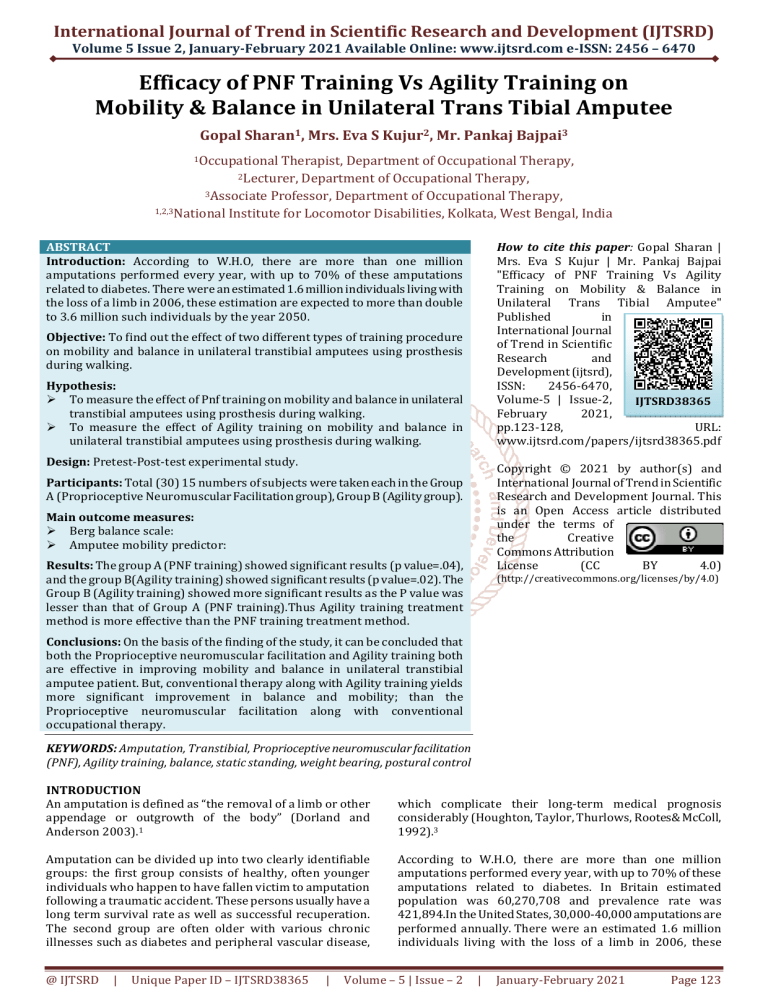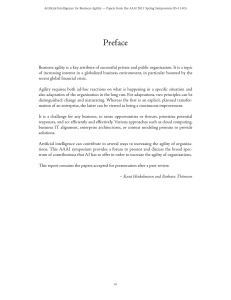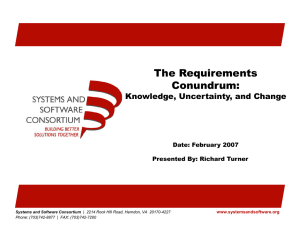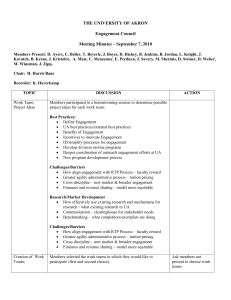
International Journal of Trend in Scientific Research and Development (IJTSRD)
Volume 5 Issue 2, January-February 2021 Available Online: www.ijtsrd.com e-ISSN: 2456 – 6470
Efficacy of PNF Training Vs Agility Training on
Mobility & Balance in Unilateral Trans Tibial Amputee
Gopal Sharan1, Mrs. Eva S Kujur2, Mr. Pankaj Bajpai3
1Occupational
Therapist, Department of Occupational Therapy,
2Lecturer, Department of Occupational Therapy,
3Associate Professor, Department of Occupational Therapy,
1,2,3National Institute for Locomotor Disabilities, Kolkata, West Bengal, India
How to cite this paper: Gopal Sharan |
Mrs. Eva S Kujur | Mr. Pankaj Bajpai
"Efficacy of PNF Training Vs Agility
Training on Mobility & Balance in
Unilateral Trans Tibial Amputee"
Published
in
International Journal
of Trend in Scientific
Research
and
Development (ijtsrd),
ISSN:
2456-6470,
Volume-5 | Issue-2,
IJTSRD38365
February
2021,
pp.123-128,
URL:
www.ijtsrd.com/papers/ijtsrd38365.pdf
ABSTRACT
Introduction: According to W.H.O, there are more than one million
amputations performed every year, with up to 70% of these amputations
related to diabetes. There were an estimated 1.6 million individuals living with
the loss of a limb in 2006, these estimation are expected to more than double
to 3.6 million such individuals by the year 2050.
Objective: To find out the effect of two different types of training procedure
on mobility and balance in unilateral transtibial amputees using prosthesis
during walking.
Hypothesis:
To measure the effect of Pnf training on mobility and balance in unilateral
transtibial amputees using prosthesis during walking.
To measure the effect of Agility training on mobility and balance in
unilateral transtibial amputees using prosthesis during walking.
Design: Pretest-Post-test experimental study.
Copyright © 2021 by author(s) and
International Journal of Trend in Scientific
Research and Development Journal. This
is an Open Access article distributed
under the terms of
the
Creative
Commons Attribution
License
(CC
BY
4.0)
Participants: Total (30) 15 numbers of subjects were taken each in the Group
A (Proprioceptive Neuromuscular Facilitation group), Group B (Agility group).
Main outcome measures:
Berg balance scale:
Amputee mobility predictor:
Results: The group A (PNF training) showed significant results (p value=.04),
and the group B(Agility training) showed significant results (p value=.02). The
Group B (Agility training) showed more significant results as the P value was
lesser than that of Group A (PNF training).Thus Agility training treatment
method is more effective than the PNF training treatment method.
(http://creativecommons.org/licenses/by/4.0)
Conclusions: On the basis of the finding of the study, it can be concluded that
both the Proprioceptive neuromuscular facilitation and Agility training both
are effective in improving mobility and balance in unilateral transtibial
amputee patient. But, conventional therapy along with Agility training yields
more significant improvement in balance and mobility; than the
Proprioceptive neuromuscular facilitation along with conventional
occupational therapy.
KEYWORDS: Amputation, Transtibial, Proprioceptive neuromuscular facilitation
(PNF), Agility training, balance, static standing, weight bearing, postural control
INTRODUCTION
An amputation is defined as “the removal of a limb or other
appendage or outgrowth of the body” (Dorland and
Anderson 2003).1
which complicate their long-term medical prognosis
considerably (Houghton, Taylor, Thurlows, Rootes& McColl,
1992).3
Amputation can be divided up into two clearly identifiable
groups: the first group consists of healthy, often younger
individuals who happen to have fallen victim to amputation
following a traumatic accident. These persons usually have a
long term survival rate as well as successful recuperation.
The second group are often older with various chronic
illnesses such as diabetes and peripheral vascular disease,
According to W.H.O, there are more than one million
amputations performed every year, with up to 70% of these
amputations related to diabetes. In Britain estimated
population was 60,270,708 and prevalence rate was
421,894.In the United States, 30,000-40,000 amputations are
performed annually. There were an estimated 1.6 million
individuals living with the loss of a limb in 2006, these
@ IJTSRD
|
Unique Paper ID – IJTSRD38365
|
Volume – 5 | Issue – 2
|
January-February 2021
Page 123
International Journal of Trend in Scientific Research and Development (IJTSRD) @ www.ijtsrd.com eISSN: 2456-6470
estimation are expected to more than double to 3.6
million such individuals by the year 2050.
are very much effective in improving the mobility and
balance in unilateral transtibial amputee.16
Transtibial amputation is responsible for bio mechanical
changes and for modifications in both afferent and efferent
projection. Because of this impairment, equilibrium is
difficult to control for Transtibial amputees.8Walking with a
prosthetic limb is the primary goal of rehabilitation after a
lower limb amputation. With a well-planned physical
therapy program, amputees can walk in a pattern that
approximates the normal gait.7
Very few studies have been conducted, where a comparison
has been done between the PNF training and the AGILITY
training therefore the purpose of this study is to find out the
effect of PNF training Versus Agility training on balance and
mobility in unilateral transtibial amputee.
The desire of amputees to perform more vigorous indoor
and outdoor activities and sports has posed more challenges
to rehabilitation practitioners in their quest to maximize the
functional capacity of their clients. Strength, balance, and
gait training have become an integral part of the
rehabilitation protocol, which can be achieved through
agility training or through Proprioceptive neuromuscular
facilitation techniques.12
Proprioceptive neuromuscular facilitation (PNF) is an
integrated approach that treats an individual as a whole
person, rather than merely focusing on a body
segment.13Gailey and Clark et al., suggested that the
neuromuscular facilitation system may effectively achieve
static standing, weight bearing steadiness and dynamic
walking, and weight shifting stability for amputees.13
Agility can be simply defined as an ability to quickly stop and
restart motion, there is a high degree of complexity to this
motor skill. First, developing agility will provide a strong
foundation for neuromuscular control and motor skill
function, thereby establishing overall athleticism. Second,
changing directions is a common cause of injury, so by
teaching individuals proper movement mechanics we may
be able to reduce injury risk. Finally, a heightened ability to
quickly change directions will enhance overall performance
in both proactive offensive and reactive defensive
circumstances.15
AIM AND OBJECTIVES
AIM:
To find out the effect of two different types of training
procedure on mobility and balance in unilateral transtibial
amputees using prosthesis during walking.
OBJECTIVES:
To measure the effect of Pnf training on mobility and
balance in unilateral transtibial amputees using
prosthesis during walking.
To measure the effect of Agility training on mobility and
balance in unilateral transtibial amputees using
prosthesis during walking.
EXPERIMENTAL HYPOTHESIS:
There will be significant difference on mobility and balance
in the Pnf training versus Agility training in unilateral
transtibial amputee.
NULL HYPOTHESIS
There will be no significant difference on mobility and
balance in the Pnf training versus Agility training in
unilateral transtibial amputees.
MATERIAL AND METHODS
STUDY AREA:
Department of Occupational Therapy, NILD, Kolkata
STUDY SAMPLE:
Subjects referred from OPD with a diagnosis of unilateral
transtibial amputee were taken for the study.
Agility training helps in strengthening and conditioning
program of the lower limb and focuses on increasing the
balance confidence of the lower limb amputee.14Agility is
commonly defined as an effective and quick coupling of
braking, changing directions and accelerating again while
maintaining motor control in either a vertical or horizontal
direction.15
STUDY PERIOD:
Study duration was 4 weeks.
Essential components of smooth and energy-efficient
walking are good balancing abilities and postural control. A
Canadian study (Miller et al, 2001) examined prevalence and
risk factors of falling and fear of falling among lower limb
amputees. They included in the study 435 people with lower
limb amputation (75% transtibial amputations, 25%
transfemoral amputations). The results have shown that
approximately 50% of subjects experienced falling and the
same percentage of subjects reported fear of falling.
Conversely, mastering balance abilities improves the
amputee's prosthetic skills and provides confidence for gait
and more complicated tasks.
SAMPLE DESIGN:A sample of convenience for the Group A&
B recruited from the Department of Occupational Therapy
services at NILD,OPD
These studies are showing that proprioceptive
neuromuscular facilitation training and agility training both
@ IJTSRD
|
Unique Paper ID – IJTSRD38365
|
SAMPLE SIZE:
Total 15 numbers of subjects were taken each in the Group
A(Proprioceptive Neuromuscular Facilitation group) Group
B(Agility group).
STUDY DESIGN:
This is a Pretest-Post-test experimental study consisting of
the comparison of balance and mobility in patients with
unilateral transtibial amputee.
INCLUSION CRITERIA:
1. Both male and female.
2. Age between 21 to 50 years.
3. Only unilateral transtibial amputee using patella tendon
bearing socket.
4. Cause of amputation – traumatic.
Volume – 5 | Issue – 2
|
January-February 2021
Page 124
International Journal of Trend in Scientific Research and Development (IJTSRD) @ www.ijtsrd.com eISSN: 2456-6470
5.
6.
7.
8.
Full ROM of Hip joint, knee joint and strength ≥ 4 in
MMT.
Good upper extremity strength.
Able to understand the command.
Immediately after discharge and fitment of prosthesis.
EXCLUSION CRITERIA:
1. Other associated Neurological or Orthopedics condition.
2. Complicated stump (pain, wound, etc.)
3. Subjects having associated psychiatric condition.
4. Subjects with sensory motor impairment due to a
neurological condition.
5. Subjects with perceptual disorder.
OUTCOME MEASURES
1. BERG BALANCE SCALE:
2. AMPUTEE MOBILITY PREDICTOR:
PROCEDURE
Informed consents were obtained from all participants.
Baseline assessment were performed on Berg Balance
Scale(BBS) and Amputee mobility Predictor(AMP) Screening
of participants were done on the basis of inclusion criteria
including scoring of Berg Balance Scale(BBS) and Amputee
mobility Predictor(AMP).Others were excluded on the basis
of medical reports. Now patients were randomly divided into
two groups, Group A (PNF training) and Group B (Agility
training). Patients in Group A were given Proprioceptive
neuromuscular facilitation along with Conventional
Occupational Therapy and patients in Group B were given
agility training along with Conventional Occupational
Therapy. Subjects of both the groups were treated three days
a week for a total period of 4 weeks. Each session was of 40
minutes. Follow up assessments were done at the end of 4th
week on outcome measures.
Fig. 2Slow reversal training in unilateral transtibial
amputee
INTERVENTION FOR THE GROUP B
Agility training + Conventional Occupational Therapy
Duration of Therapy 40 minutes sessions (30 minutes for
Agility training +10minutes conventional occupational
therapy) three days in a week for 4 weeks.
INTERVENTION
INTERVENTION FOR THE GROUP A
PNF+ Conventional Occupational Therapy.
Duration of Therapy 40 minutes sessions (30 minutes for
PNF +10 minute’sconventional occupational therapy) three
days in a week for 4 weeks.
Fig. 3Agility ladder
The participants of Group A practiced PNF exercises.
PNF TRAINING
Fig. 4Agility ladder training in unilateral transtibial
Amputee
Fig. 1: Approximation
@ IJTSRD
|
Unique Paper ID – IJTSRD38365
|
Volume – 5 | Issue – 2
|
January-February 2021
Page 125
International Journal of Trend in Scientific Research and Development (IJTSRD) @ www.ijtsrd.com eISSN: 2456-6470
FLOWCHART
Unilateral transtibial Patients from
OT outdoor Screening done for the
study (n= 50)
20 Excluded
Did not met
Inclusion criteria
30 Patients were
Selected for the study
RANDOMIZATION
Proprioceptive neuromuscular
facilitation Group –A (n=15)
Agility Group B (n=15)
PRE TEST Evaluation of balance and mobility by using BBS and AMP
GROUP A (n=15)
proprioceptive neuromuscular
facilitation with conventional
occupational therapy
40mins X 3 days in a week X 4 weeks
GROUP B (n=15)
Agility training with conventional
occupational therapy
40mins X 3 days in a week X 4 weeks
POST TEST evaluation for balance and
mobility
Using BBS & AMP
Weeks post-intervention after 4weeks
POST TEST evaluation for balance and
mobility
Using BBS & AMP
Weeks post-intervention after 4weeks
Comparing both the groups for post evaluation of results
DATA ANALYSIS
The confidence interval set at p = 0.5.The Confidence Interval was kept at the standard level of 95% and the data was analyzed
using IBM SPSS Version 23 (SPSS, Inc, Chicago IL, USA).The baseline data was measured using the one-sided t-test for Berg
Balance scale and Amputee Mobility Predictor. Baseline was compared to cross check any discrepancies in the symptoms of
both the groups and also to ensure that sampling had been done properly and the subjects are randomized well. The pre and
post intervention measurements were compared using the paired sample t-test. The differences in the means were compared
between the two groups using Independent samples t-test.The significance level was kept at α=0.05 (CI=95%).The graphs were
prepared using Microsoft Excel for Mac Version 15.21.1 (2013) and the standard deviations were added to it.
RESULTS
Baseline Comparison of means within group A (PNF) and group B (AGILITY) after outcome measure
Group
Group A
Group B
Mean Age
46.52
44.21
Berg Balance Scale
38.74
36.97
Amputee Mobility Predictor
16.83
17.51
Sig (2 Tailed)
0.59
0.88
Total numbers of 30 unilateral transtibial amputee subjects were enrolled in the study. 30 completed the study with 15 each in
group A (PNF Group) Group – B (AGILITY Group). The average age of the subjects in group A was 46.52 years and group-B was
44.21 years.
@ IJTSRD
|
Unique Paper ID – IJTSRD38365
|
Volume – 5 | Issue – 2
|
January-February 2021
Page 126
International Journal of Trend in Scientific Research and Development (IJTSRD) @ www.ijtsrd.com eISSN: 2456-6470
Table 1 Group A (PNF) Within group outcome measure
Outcome Measures
Pre-intervention Post-intervention Significance
Berg Balance Scale
38.74
50.17
0.00
Amputee Mobility Predictor
16.83
29.58
0.00
The result were found to be significant for both balance and mobility.
Outcome Measures
Berg Balance Scale
Amputee Mobility Predictor
Table 2Group B (Agility)
Pre-intervention Post-intervention
36.97
47.32
17.51
25.67
Significance
0.00
0.00
The results were found to be significant for both the outcome measure of group B.
Table 3 Outcome measures of Between Group A and B
Outcome Measures
Group A Mean Difference Group B mean difference
Berg Balance Scale
11.43
10.35
Amputee Mobility Predictor
12.75
8.16
Significance
0.59
0.01
The test results shows insignificant results for balance (p= 0.59) and significant results for mobility (p= 0.01).
Table 4 Post-intervention comparison of means between Group A& Group B
Group
Berg Balance Scale Amputee Mobility Predictor Sig (2 Tailed)
Group A (PNF)
50.17
29.58
0.04
Group B (AGILITY)
47.32
25.67
0.02
The test result shows significant result for Group A (p= 0.04) and very significant results for Group B (p= 0.02)
DISCUSSION
The hypothesis of the study was to compare the efficacy of
PNF training vs AGILITY training on mobility and balance in
unilateral transtibial amputee. The results are found to be
significant for both the treatment methods. The group A(PNF
training) showed significant results (p value=.04),and the
group B(Agility training) showed significant results (p
value=.02)45. The Group B (Agility training) showed more
significant results as the P value was lesser than that of
Group A(PNF training).Thus Agility training treatment
method is more effective than the PNF training treatment
method.
In the study agility training is more effective may be
attributed to the fact that agility training put forth with a
new definition of agility is purposed: “a rapid whole body
movement with change of velocity of direction in response to
a stimulus”. Agility has relationship with trainable physical
qualities such as strength, power and technique, as well as
cognitive components such as visual scanning techniques,
visual scanning speed and anticipation.
The results of the study is supported by another study by D.
Vittas et al., (1986), stated that in amputee the postural sway
is the main component affected and literature suggests that
for a person to maintain balance requires coordination of
input from multiple sensory systems including the
vestibular, somatosensory and visual systems46.
The objective of the study was to see the effect of Pnf
training on mobility .The results indicate there is an
improvement in mobility after pnf training. The p value
is(p=.04).It is assumed that the improvement in mobility
may be attributed to the fact that Proprioceptive
neuromuscular facilitation improves the dynamic balance
and overall mobility of patients. The said technique
integrates manual contacts, verbal commands and vision to
carry out, refine and improve muscle functioning and gait.
@ IJTSRD
|
Unique Paper ID – IJTSRD38365
|
There is a significant increase of muscle strength of hip
flexors, hip extensors, knee flexors and knee extensors of
residual limbs of unilateral transtibial amputees of the group
which received proprioceptive neuromuscular facilitation
technique (PNF). The improvement in the group A can be
attributed to improve mobility in the unilateral transtibial
amputee.
This is supported by a study conducted by
HadeyaAnjum(2016).48
He
concluded
that
the
Proprioceptive neuromuscular facilitation technique was
better in improving locomotion and functional status of
people with transtibial amputation as compared to the
traditional prosthetic strength training. The techniques were
equally effective for improving step length, step width, and
cadence in trans-tibial amputees.
The second objective of the study is to find the effect of pnf
training on balance in unilateral transtibial amputees while
walking. The results indicate there is an improvement in
balance after pnf training. The p value is (p=.04).The
improvement in balance may be attributed to the fact that
Proprioceptive neuromuscular facilitation improves the
dynamic balance hence it is also suitable to affirm that PNF
training programme used in this study induced a response
more related to and appropriate reaction to balance
perturbation then to strength level improves.
The third objective of the study was to see the effect of
Agility training on mobility. The p value is (p = 0.01), Taskin
Mine et al., (2014) reported that the energy expenditure
required to walk with a prosthesis is far higher than that
required for an able-bodied person. In that study he found
that a significant positive correlation existed between
quickness with speed. Speed and quickness are important
components of sport performance. Speed and quickness
training is perfect for seniors because it will condition fitness
aspects that are generally lost with age-speed and quickness.
Volume – 5 | Issue – 2
|
January-February 2021
Page 127
International Journal of Trend in Scientific Research and Development (IJTSRD) @ www.ijtsrd.com eISSN: 2456-6470
The results of the study is supported by another study by
GoranSporis et al. (2010), agility training could improve leg
extensor power and the mobility of the person by improving
muscle coordination. He concluded that agility training has a
positive effect on movement technique and the ability to
produce force in leg muscle more efficiently. These
movements improve intra and inter-muscular coordination,
which results in a better dynamic performance.
[8]
The results of the study is supported by another study by
D.Vittas et al.(1986), stated that in amputee postural sway is
the main component affected and literature suggest that for
a person to maintain balance requires coordination of input
from multiple sensory systems including the vestibular,
somatosensory and visual systems50.
[10]
The fourth objective of the study the effect of agility training
on balance. The result indicates that there is the significant
improvement in balance after agility training. The P value is
(<.05). The study results is similar to another study by
Warren B. Young et al.(2015), there he concluded that the
cognitive element of the agility is the important for
performance. Small side’s games improve the agility of the
patient. Development in the strength qualities and physical
qualities improve the change of direction speed and balance.
CONCLUSION
The purpose of the current study was to compare the effect
of Proprioceptive neuromuscular facilitation VS Agility
training in unilateral transtibial amputee on mobility and
balance. On the basis of the finding of the study, it can be
concluded that both the Proprioceptive neuromuscular
facilitation and Agility training both are effective in
improving mobility and balance in unilateral transtibial
amputee patient. But, conventional therapy along with
Agility training yields more significant improvement in
balance and mobility; than the Proprioceptive
neuromuscular facilitation along with conventional
occupational therapy. The Agility training has a key role to
play in tailoring strategies and interventions to improve the
balance and mobility in unilateral transtibial amputee
patient.
REFERENCES
[1] Dorland, W. A. N. and Anderson, D. M. (2003).
Dorland's illustrated medical dictionary. Philadelphia,
Saunders.
[2] Michelle M. Lusardi, PT, DPT, PhD. Orthotics and
Prosthetics in rehabilitation.(458-459)
[3] Houghton, A. D., Taylor, P. R., Thurlow, S., Rootes, E., &
McColl, J. (1992). Success rates for rehabilitation of
vascular amputees: implications for preoperative
assessments and amputation level. British Journal of
Surgery. 79 (8): 753-755
[4] Pooja GD, Sangeeta L. Prevelance and aetiology of
amputation in Kolkata, India: A retrospective analysis.
Hong Kong Physiother J 2013;31:36-40
[5] James W. Breakey. Body Image: The Lower-Limb
Amputee. Journal Of Physical Oceanography: Nov
2007: 9(2):58-66.
[6] Viswanathan Vijay MD, PHD, WHO collaborating
center for Research, Amputation prevention initiative
in South India. (January 26, 2005).
[7] BuckleyJGPostural sway and active balance
performance in highly active lower-limb amputees.
Am J Phys Med Rehabil 2002; 81:13+20.
@ IJTSRD
|
Unique Paper ID – IJTSRD38365
|
[9]
[11]
[12]
[13]
[14]
[15]
[16]
[17]
[18]
[19]
[20]
[21]
[22]
[23]
Viton JM, Mouchnino L, Mille ML, Cincera M, Delarque
A, PedottiA,et al. Equilibrium and movement control
strategies in trans-tibial amputees. ProsthetOrthot I
2000; 24:108+16.
Gailey RS, Clark CR. Physical therapy management of
adult lower limb amputee. In: Bowker JH, Michael JW,
editors. Atlas of limb prosthetics: surgical, prosthetic
and rehabilitation principles. 2nd ed. St. Louis,
Baltimore: Mosby Yearbook; 1992. p. 569e97.
Mattes SJ, Martin PE, Royer TD. Walking symmetry
and energy cost in persons with unilateral transtibial
amputations: matching prosthetic and intact limb
inertial properties. Arch Phys Med Rehabil 2000;
81:561-8.
Hak L, van Dieën JH, Wurff PV, Prins MR, Mert A, Beek
PJ, Houdijk H. Walking in an unstable environment:
Strategies used by transtibial amputees to prevent
falling during gait. Arch Phys Med Rehabil. 2013 Aug;
94(8): 1435-41.
Baker P, Hewison S. Gait recovery pattern of
unilateral lowerlimb amputees during rehabilitation.
ProsthetOrthotInt 1990; 14:80-4.
PallaviSahay, Santosh Kr. Prasad ShahnawazAnwer, P.
K. Lenka, Ratnesh Kumar, Efficacy of proprioceptive
neuromuscular facilitation techniques versus
traditional prosthetic training for improving
ambulatory function in transtibial amputees
Yi_giter K, Sener G, Erbahc¸eci F, Bayar K, Ulger OG,
Akdo_gan S. A comparison of traditional prosthetic
training versus proprioceptive neuromuscular
facilitation resistive gait training with trans-femoral
amputees. ProsthetOrthotInt 2002; 26:213-7.
Plisk, S. S. Speed, Agility, and Speed-Endurance
Development. In: Essentials of Strength Training and
Conditioning. T.R. Baechle and R.W. Earle, eds.
Champaign:Human Kinetics, 2000. pp. 471-492.
Miller WC et al., The prevalence and risk factors of
falling and fear of falling among lower extremity
amputees. Arch Phys Med Rehabilitation 2001.
Susan B. O’Sullivan, Thomas J.Schmitz Physical
Rehabilitation 5th edition
Paul F. Pasquina, , Phillip R. Bryant, , Mark E. Huang,
Toni L. Roberts,Virginia S. Nelson, Katherine M. Flood
Limb deficiency and prosthetic management. Arch
Phys Med RehabilVol 87, Suppl 1, March 2006
Gonzalez EG, Corcoran PJ, Reyes RL. Energy
expenditure in below-knee amputees: correlation
with stump length. Arch Phys Med Rehabil 1974;
55:111-9.
van der Linde H, Hofstad CJ, Geurts AC, Postema K,
Geertzen JH, van Limbeek J. A systematic literature
review of the effect of different prosthetic
components on human functioning with a lower-limb
prosthesis. J Rehabil Res Dev 2004; 41:555-70.
O'Sullivan SB, Schmitz TJ, Fulk G. Physical
rehabilitation: FA Davis; 2013. 12.
Chin T, Sawamura S, Shiba R, et al. Effect of an
intelligent prosthesis (IP) on the walking ability of
young transfemoral amputees: comparison of IP users
with able-bodied people. Am J Phys Med Rehabil
2003;82:447-51
Snyder RD, Powers CM, Fontaine C, Perry J. The effect
of five prosthetic feet on the gait and loading of the
sound limb in dysvascular below-knee amputees. J
Rehabil Res Dev 1995; 32: 309-15.
Volume – 5 | Issue – 2
|
January-February 2021
Page 128




